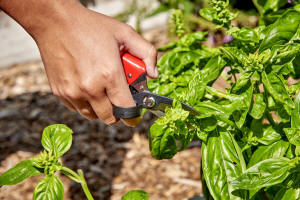|
 The
Why and How of Deadheading The
Why and How of Deadheading
By Melinda Myers
[May 31, 2025]
Keep your flowers blooming longer and your garden a
bit tidier with deadheading. Removing faded flowers can promote
repeat bloom on some plants, encourage fuller, more compact growth,
and tidy up the garden. |
|
Use a bypass hand pruner, garden snips or other
dead-heading tool to remove faded flowers. Bypass tools have two
sharp blades like scissors, resulting in a clean cut that closes
quickly, leaving your plant looking its best. Corona Tool’s Ergocut
dead header (coronatools.com) has a finger loop that provides better
control and an ergonomic design for less stress on your hands and
wrist.
The type of flower will influence how and where to make the cut. In
general, remove the stem of faded blooms back to the first set of
healthy leaves or nearby flower buds.
Remove the flower stem of salvias, speedwells (Veronicas), and
snapdragons as the blooms begin to fade. Cut below the spike of
flowers just above the first set of leaves or the side shoots where
the new flower buds are forming.
Encourage additional blossoms and improve Shasta daisy’s appearance
by removing faded flowers. Prune back just above a set of healthy
leaves.
Cut the flowers of plants like Armeria and coral bells back to the
base of the flower stems that arise from the foliage. This improves
the appearance and encourages more blooms on some of this type of
flowering perennial.

Plants like daylilies and balloon flowers require a
bit different care. Remove the individual blooms as they fade if you
don’t like looking at the faded flowers. Once all the individual
flowers have bloomed out, you can cut the flower stem back at the
base.
Removing fading flowers of fuchsia and lantana will prevent the
plants from going to seed and encourage more blooms. Remove any
berries that do form to keep these plants flowering throughout the
growing season.
Deadheading peonies is strictly for aesthetics and won’t extend the
bloom time. Remove the faded flowers or seedpods as they form. Cut
just above a healthy set of leaves to keep the stems more upright
and create a tidier appearance in your garden.
Prevent some flowers, like columbine, Amsonia, and Alliums from
reseeding and spreading throughout the garden by removing the faded
flowers. Even though it won’t promote additional blooms, it will
help eliminate unwanted seedlings in next year’s garden.
[to top of second column] |

Reduce time spent deadheading by including some
self-cleaning, also called free-flowering plants, like impatiens,
fibrous begonias, Calibrachoa, and moss rose. Lobelia, many of the
newer petunias, and verbenas are also self-cleaning but may benefit
from a bit of grooming. Prune back heat-stressed lobelia and verbena
that get leggy and petunia stems that need to be kept in bounds.
Allow seedheads to develop on coneflowers, rudbeckias, and other
plants that provide winter interest and food for the birds. And
consider skipping the deadheading of late blooming perennials. This
allows them to prepare for winter and form seedpods for additional
winter interest.
And while you are out in the garden deadheading, pick a few flowers
at their peak to enjoy in a summer bouquet indoors.
Remove flowers as they appear on coleus, grown for
its colorful foliage, to promote more compact growth. Late blooming,
flowerless varieties and self-branching coleus hybrids reduce or
eliminate time spent on this task.
Melinda Myers has written more than 20 gardening books,
including the Midwest Gardener’s Handbook, 2nd Edition and Small
Space Gardening. She hosts The Great Courses “How to Grow Anything”
instant video and DVD series and the nationally syndicated Melinda’s
Garden Moment TV & radio program. Myers is a columnist and
contributing editor for Birds & Blooms magazine and was commissioned
by Summit for her expertise to write this article. Myers’ website is www.MelindaMyers.com.
[Photo courtesy of MelindaMyers.com]
 |